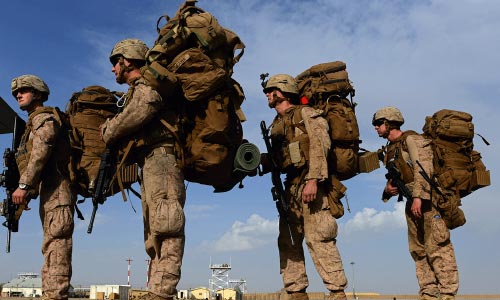In the eve of signing peace agreement between US and Taliban, there are great uncertainties whether the U.S. and its allies leave Afghanistan in clutches of terrorist’s networks or responsibly and gradually leave the country. Therefore, some of the Afghan people appealed US officials through formal and informal letters in order not to leave the country but others seems happy as the foreign forces are to leave the country hoping to end the world increasing political competitions in Afghanistan. The uncertainty mainly rooted in paradoxical positions of US officials on complete or incomplete withdrawal of US forces from the country.
According to Trump’s latest position, the US will always be in Afghanistan—while he had promised the American people to end the useless war in anyway. Based on his previous position, his chief negotiator, Zalmay Khalilzad worked on a plan for an almost total withdrawal, but as Trump said on Thursday, the U.S. would “always” have a “presence” in Afghanistan. As pointed out, Zalmay Khalilzad, is trying to quietly iron out with the Taliban and the Afghan government a deal that could include an almost complete withdrawal of American troops by the 2020 election.
As US Media indicates, initially the demand for the complete withdrawal plan came from the Oval Office earlier this month when President Trump told his advisers and cabinet officials that he wanted completely out of the country by the time he took the stage at his last campaign event in 2020.The plan is ruffling feathers inside the Trump administration as senior officials in the Department of Defense and also inside Afghanistan, the Afghan government pushed the U.S. to keep some forces in the country for the foreseeable future. Now, Khalilzad is under pressure to please all sides, including the many factions of the Taliban, which has long demanded that all foreign troops leave the country.
Some of the US officials have continuously pushed for the total withdrawal of troops but in the other times they expressed different ideas. Seemingly, the dual positions indicate that the US main strategy requires staying but Trump wants to use the withdrawal as a way of proving his foreign policy bona fides in the lead-up to the 2020 election. Anyway, to unite the dissimilar positions and please the Taliban negotiators, it seems that the U.S. envoy is trying to formalize the details of the 14-month plan and considering whether to leave a small contingent of residual forces in the country, potentially in an advisory capacity.
According to experts, the peace deal should not be based on a blind trust but it must contain clear requirements and commitments that are subject to clear outcome in the future. Any potential deal should bring together all sides for negotiation, enable a useful stay or withdrawal of American forces, and ensure the security of the country and the region. But it’s unclear how much of these negotiations will be fully consummated. Off-and-on talks with the Taliban have been going on, in one form or another, over the course of a decade. And it’s not at all apparent that every faction of the Taliban will adhere to a deal, even if one is proclaimed.
Meanwhile, one of the Taliban’s main demands from the US negotiator is the total withdrawal of U.S. troops from Afghanistan. As reports quoted, some senior officials in the upper echelons of the Trump administration national security apparatus say as long as the U.S. enacts strict protocols and monitoring, a plan for an almost complete drawdown can proceed. The U.S. has to give the Taliban enough for the group to feel comfortable promoting the fact that it achieved the withdrawal of troops “But at the same time we need to make sure that the Taliban doesn’t just wait it out and then go take over swaths of land and implement their own.”
Anyway, the latest position expressed by US and NATO officials confirmed that the international forces are going to reduce not fully withdraw. Accordingly, the withdrawal plan need to be conditions-based and would allow the U.S. to change course on troop levels if the parties reneged on any part of the agreement, which has yet to be finalized. Some of the conditions floated in the ongoing conversations include the Taliban committing to adhering to the country’s constitution, upholding women’s rights, and agreeing to continuously engage in good-faith talks with officials in the Ghani government.
The latest Trump’s position is coordinated with latest NATO positions as a day before NATO Senior Civilian Representative for Afghanistan, Nicolas Kay, said that international forces will remain in Afghanistan even after a peace agreement in order to support the Afghan National Defense and Security Forces. “Let me assure you very very clearly, NATO is not leaving, NATO is committed to staying and supporting Afghan national defense and security forces,” Mr. Kay said. Some 14,000 US troops have remained in Afghanistan within the framework of NATO Resolute Support Mission (RS) to train, advice and assist the conventional Afghan security forces.
Thus, other top US officials believe that it is too early to talk about a full American troop withdrawal from Afghanistan. As reported quoted, Gen. Joseph Dunford, chairman of the Joint Chiefs of Staff, said that any U.S. deal with the Taliban will be based on security conditions on the ground and that Afghan forces aren’t yet able to secure the country without help from allied forces.“I’m not using the withdraw word right now,” Dunford said. “It’s our judgment that the Afghans need support to deal with the level of violence” in the country today.
Home » Opinion » International Forces: At The Crossroads of Complete or Incomplete Withdrawal from Afghanistan
International Forces: At The Crossroads of Complete or Incomplete Withdrawal from Afghanistan
| Mohammad Zahir Akbari

